Source Identification of PM2.5 and Organic Carbon During Various Haze Episodes in a Typical Industrial City by Integrating with High-Temporal-Resolution Online Measurements of Organic Molecular Tracers
Abstract
1. Introduction
2. Literature Review
3. Methodology
3.1. Technical Framework
3.2. The Descriptions of the Observation Station
3.3. Measurements of Organic Molecules and Other Species
3.4. PM2.5 Mass Reconstruction
3.5. PMF Model
3.6. Trajectory Statistics Model and Backward Trajectory Cluster
4. Results
4.1. Concentrations of PM2.5 Components
4.2. Concentration Characteristics
4.2.1. Inorganic Components
4.2.2. Organic Molecule Tracers
4.3. Source Identification Based on the PMF Model
- (1)
- Fireworks source: This kind of source was characterized by high loads of ions K+, Mg2+, Cu, and Se, which possess distinctive flame colors and are primarily sourced from fireworks during the Spring Festival [50].
- (2)
- Industrial processes source: Characterized by Cr, Ni, V, and other elements, representing the contribution of industrial activities and industrial fuel use to PM2.5 [51].
- (3)
- Mobile source: Characterized by contributions from n-alkanes, hopanes, PAHs, and EC, primarily from the combustion of fossil fuels [52].
- (4)
- Coal combustion sources: Primarily generated from coal combustion, characterized by high contributions of As, OC, EC, and other elements [53]. Furthermore, a portion of the contribution stems from biomass burning emissions characterized by K+ ions.
- (5)
- SA source: This factor is primarily associated with emissions from mobile sources, industrial processes, coal combustion, and agricultural activities. These emissions undergo secondary atmospheric reactions, producing substantial amounts of SO42−, NO3−, and NH4+, along with a minor fraction of organic matter.
- (6)
- Dust source: Characterized by high proportions of Ca, Si, and Fe elements, primarily sourced from road dust, sand dust, and construction dust [54].
- (7)
- SOA source: This factor is characterized by secondary reaction products derived from biogenic emissions of isoprene and α-pinene. It also contains substantial fractions of alkanes, aromatic hydrocarbons, naphthalene, levoglucosan, and hopanes, as well as oxidation products originating from mobile sources and biomass burning.
- (8)
4.4. Backward Trajectories of Pollution Process
5. Discussion
5.1. Interpretation of Pollution Formation Based on Measurements
5.2. Influence of Transport Pathways
5.3. Source Analysis
5.4. Limitations and Future Research
6. Conclusions
Supplementary Materials
Author Contributions
Funding
Institutional Review Board Statement
Informed Consent Statement
Data Availability Statement
Conflicts of Interest
References
- Gao, M.; Beig, G.; Song, S.; Zhang, H.; Hu, J.; Ying, Q.; Liang, F.; Liu, Y.; Wang, H.; Lu, X.; et al. The Impact of Power Generation Emissions on Ambient PM2.5 Pollution and Human Health in China and India. Environ. Int. 2018, 121, 250–259. [Google Scholar] [CrossRef] [PubMed]
- Zhang, Z.; Song, N.; Wang, J.; Liu, J.; Shi, L.; Du, J. Effect of PM2.5 Air Pollution on the Global Burden of Neonatal Diarrhea from 1990 to 2019. Environ. Pollut. 2025, 367, 125604. [Google Scholar] [CrossRef]
- Gui, X.; Ren, J.; Wang, G.; Wang, Y.; Zhang, M.; Wang, X. Retrieval of Atmospheric Visibility and Its Driving Factors in Shanghai, China. Atmosphere 2025, 16, 1181. [Google Scholar] [CrossRef]
- Hu, X.; Belle, J.H.; Meng, X.; Wildani, A.; Waller, L.A.; Strickland, M.J.; Liu, Y. Estimating PM2.5 Concentrations in the Conterminous United States Using the Random Forest Approach. Environ. Sci. Technol. 2017, 51, 6936–6944. [Google Scholar] [CrossRef]
- Chow, W.S.; Liao, K.; Huang, X.H.H.; Leung, K.F.; Lau, A.K.H.; Yu, J.Z. Measurement Report: The 10-Year Trend of PM2.5 Major Components and Source Tracers from 2008 to 2017 in an Urban Site of Hong Kong, China. Atmos. Chem. Phys. 2022, 22, 11557–11577. [Google Scholar] [CrossRef]
- Yu, Y.; Dai, C.; Wei, Y.; Ren, H.; Zhou, J. Air Pollution Prevention and Control Action Plan Substantially Reduced PM2.5 Concentration in China. Energy Econ. 2022, 113, 106206. [Google Scholar] [CrossRef]
- Volckens, J. Summertime Trends in U.S. Population Exposure to Fine Particulate Air Pollution (PM2.5) from Wildfire Smoke. Environ. Sci. Technol. Lett. 2024, 11, 1182–1186. [Google Scholar] [CrossRef]
- Zhang, Q.; Jimenez, J.L.; Canagaratna, M.R.; Allan, J.D.; Coe, H.; Ulbrich, I.; Alfarra, M.R.; Takami, A.; Middlebrook, A.M.; Sun, Y.L.; et al. Ubiquity and Dominance of Oxygenated Species in Organic Aerosols in Anthropogenically-influenced Northern Hemisphere Midlatitudes. Geophys. Res. Lett. 2007, 34, 2007GL029979. [Google Scholar] [CrossRef]
- Zhu, S.; Zhou, M.; Qiao, L.; Huang, D.D.; Wang, Q.; Wang, S.; Gao, Y.; Jing, S.; Wang, Q.; Wang, H.; et al. Evolution and Chemical Characteristics of Organic Aerosols during Wintertime PM2.5 Episodes in Shanghai, China: Insights Gained from Online Measurements of Organic Molecular Markers. Atmos. Chem. Phys. 2023, 23, 7551–7568. [Google Scholar] [CrossRef]
- Shi, T.; Hu, Y.; Liu, M.; Li, C.; Zhang, C.; Liu, C. How Do Economic Growth, Urbanization, and Industrialization Affect Fine Particulate Matter Concentrations? An Assessment in Liaoning Province, China. Int. J. Environ. Res. Public Health 2020, 17, 5441. [Google Scholar] [CrossRef]
- Fabbri, D.; Torri, C.; Simoneit, B.R.T.; Marynowski, L.; Rushdi, A.I.; Fabiańska, M.J. Levoglucosan and Other Cellulose and Lignin Markers in Emissions from Burning of Miocene Lignites. Atmos. Environ. 2009, 43, 2286–2295. [Google Scholar] [CrossRef]
- Sullivan, A.P.; May, A.A.; Lee, T.; McMeeking, G.R.; Kreidenweis, S.M.; Akagi, S.K.; Yokelson, R.J.; Urbanski, S.P.; Collett, J.L., Jr. Airborne Characterization of Smoke Marker Ratios from Prescribed Burning. Atmos. Chem. Phys. 2014, 14, 10535–10545. [Google Scholar] [CrossRef]
- Tian, Y.; Liu, X.; Huo, R.; Shi, Z.; Sun, Y.; Feng, Y.; Harrison, R.M. Organic Compound Source Profiles of PM2.5 from Traffic Emissions, Coal Combustion, Industrial Processes and Dust. Chemosphere 2021, 278, 130429. [Google Scholar] [CrossRef]
- Wong, Y.K.; Huang, X.H.H.; Cheng, Y.Y.; Yu, J.Z. Estimating Primary Vehicular Emission Contributions to PM2.5 Using the Chemical Mass Balance Model: Accounting for Gas-Particle Partitioning of Organic Aerosols and Oxidation Degradation of Hopanes. Environ. Pollut. 2021, 291, 118131. [Google Scholar] [CrossRef]
- Graham, B.; Mayol-Bracero, O.L.; Guyon, P.; Roberts, G.C.; Decesari, S.; Facchini, M.C.; Artaxo, P.; Maenhaut, W.; Köll, P.; Andreae, M.O. Water-soluble Organic Compounds in Biomass Burning Aerosols over Amazonia 1. Characterization by NMR and GC-MS. J. Geophys. Res. Atmos. 2002, 107, LBA-14. [Google Scholar] [CrossRef]
- Wang, G.; Kawamura, K. Molecular Characteristics of Urban Organic Aerosols from Nanjing: A Case Study of a Mega-City in China. Environ. Sci. Technol. 2005, 39, 7430–7438. [Google Scholar] [CrossRef]
- Sun, Y.-L.; Zhang, Q.; Schwab, J.J.; Demerjian, K.L.; Chen, W.-N.; Bae, M.-S.; Hung, H.-M.; Hogrefe, O.; Frank, B.; Rattigan, O.V.; et al. Characterization of the Sources and Processes of Organic and Inorganic Aerosols in New York City with a High-Resolution Time-of-Flight Aerosol Mass Apectrometer. Atmos. Chem. Phys. 2011, 11, 1581–1602. [Google Scholar] [CrossRef]
- He, X.; Wang, Q.; Huang, X.H.H.; Huang, D.D.; Zhou, M.; Qiao, L.; Zhu, S.; Ma, Y.; Wang, H.; Li, L.; et al. Hourly Measurements of Organic Molecular Markers in Urban Shanghai, China: Observation of Enhanced Formation of Secondary Organic Aerosol during Particulate Matter Episodic Periods. Atmos. Environ. 2020, 240, 117807. [Google Scholar] [CrossRef]
- Huang, D.D.; Zhu, S.; An, J.; Wang, Q.; Qiao, L.; Zhou, M.; He, X.; Ma, Y.; Sun, Y.; Huang, C.; et al. Comparative Assessment of Cooking Emission Contributions to Urban Organic Aerosol Using Online Molecular Tracers and Aerosol Mass Spectrometry Measurements. Environ. Sci. Technol. 2021, 55, 14526–14535. [Google Scholar] [CrossRef] [PubMed]
- Williams, B.J.; Goldstein, A.H.; Kreisberg, N.M.; Hering, S.V. An In-Situ Instrument for Speciated Organic Composition of Atmospheric Aerosols: T Hermal Desorption a Erosol G C/MS-FID (TAG). Aerosol Sci. Technol. 2006, 40, 627–638. [Google Scholar] [CrossRef]
- Li, R.; Wang, Q.; He, X.; Zhu, S.; Zhang, K.; Duan, Y.; Fu, Q.; Qiao, L.; Wang, Y.; Huang, L.; et al. Source Apportionment of PM2.5 in Shanghai Based on Hourly Organic Molecular Markers and Other Source Tracers. Atmos. Chem. Phys. 2020, 20, 12047–12061. [Google Scholar] [CrossRef]
- Li, Q.; Zhang, K.; Li, R.; Yang, L.; Yi, Y.; Liu, Z.; Zhang, X.; Feng, J.; Wang, Q.; Wang, W.; et al. Underes-timation of Biomass Burning Contribution to PM2.5 Due to Its Chemical Degradation Based on Hourly Meas-urements of Organic Tracers: A Case Study in the Yangtze River Delta (YRD) Region, China. Sci. Total Environ. 2023, 872, 162071. [Google Scholar] [CrossRef]
- Li, R.; Zhang, K.; Li, Q.; Yang, L.; Wang, S.; Liu, Z.; Zhang, X.; Chen, H.; Yi, Y.; Feng, J.; et al. Characteristics and Degradation of Organic Aerosols from Cooking Sources Based on Hourly Observations of Organic Molecular Markers in Urban Environments. Atmos. Chem. Phys. 2023, 23, 3065–3081. [Google Scholar] [CrossRef]
- Li, H.; Ma, Y.; Duan, F.; He, K.; Zhu, L.; Huang, T.; Kimoto, T.; Ma, X.; Ma, T.; Xu, L.; et al. Typical Winter Haze Pollution in Zibo, an Industrial City in China: Characteristics, Secondary Formation, and Regional Contribution. Environ. Pollut. 2017, 229, 339–349. [Google Scholar] [CrossRef] [PubMed]
- Li, K.; Wang, X.; Li, L.; Wang, J.; Liu, Y.; Cheng, X.; Xu, B.; Wang, X.; Yan, P.; Li, S.; et al. Large Variability of O3-Precursor Relationship during Severe Ozone Polluted Period in an Industry-Driven Cluster City (Zibo) of North China Plain. J. Cleaner Prod. 2021, 316, 128252. [Google Scholar] [CrossRef]
- Solomon, P.A.; Crumpler, D.; Flanagan, J.B.; Jayanty, R.K.M.; Rickman, E.E.; McDade, C.E. U.S. National PM2.5 Chemical Speciation Monitoring Networks—CSN and IMPROVE: Description of Networks. J. Air Waste Manag. Assoc. 2014, 64, 1410–1438. [Google Scholar] [CrossRef]
- Yao, L.; Yang, L.; Chen, J.; Wang, X.; Xue, L.; Li, W.; Sui, X.; Wen, L.; Chi, J.; Zhu, Y.; et al. Characteristics of Carbonaceous Aerosols: Impact of Biomass Burning and Secondary Formation in Summertime in a Rural Area of the North China Plain. Sci. Total Environ. 2016, 557–558, 520–530. [Google Scholar] [CrossRef] [PubMed]
- Paatero, P.; Tapper, U. Positive Matrix Factorization: A Non-negative Factor Model with Optimal Utilization of Error Estimates of Data Values. Environmetrics 1994, 5, 111–126. [Google Scholar] [CrossRef]
- Bressi, M.; Sciare, J.; Ghersi, V.; Mihalopoulos, N.; Petit, J.-E.; Nicolas, J.B.; Moukhtar, S.; Rosso, A.; Féron, A.; Bonnaire, N.; et al. Sources and Geographical Origins of Fine Aerosols in Paris (France). Atmos. Chem. Phys. 2014, 14, 8813–8839. [Google Scholar] [CrossRef]
- Rogge, W.F.; Hildemann, L.M.; Mazurek, M.A.; Cass, G.R.; Simoneit, B.R.T. Sources of Fine Organic Aerosol. 2. Noncatalyst and Catalyst-Equipped Automobiles and Heavy-Duty Diesel Trucks. Environ. Sci. Technol. 1993, 27, 636–651. [Google Scholar] [CrossRef]
- Yang, J.; Lei, G.; Liu, C.; Wu, Y.; Hu, K.; Zhu, J.; Bao, J.; Lin, W.; Jin, J. Characteristics of Particulate-Bound n -Alkanes Indicating Sources of PM2.5 in Beijing, China. Atmos. Chem. Phys. 2023, 23, 3015–3029. [Google Scholar] [CrossRef]
- Chen, T.; Deng, L.; Zhang, H.; Li, Y.; Li, J. Polycyclic Aromatic Hydrocarbons and Normal Alkanes in Condensable Particulate Matter of Coal Combustion. J. Energy Inst. 2023, 111, 101398. [Google Scholar] [CrossRef]
- Li, C.; Li, Z.; Wang, H. Characterization and Risk Assessment of Polycyclic Aromatic Hydrocarbons (PAHs) Pollution in Particulate Matter in Rural Residential Environments in China-a Review. Sustain. Cities Soc. 2023, 96, 104690. [Google Scholar] [CrossRef]
- Pei, B.; Cui, H.; Liu, H.; Yan, N. Chemical Characteristics of Fine Particulate Matter Emitted from Commercial Cooking. Front. Environ. Sci. Eng. 2016, 10, 559–568. [Google Scholar] [CrossRef]
- Olson, C.N.; Galloway, M.M.; Yu, G.; Hedman, C.J.; Lockett, M.R.; Yoon, T.; Stone, E.A.; Smith, L.M.; Keutsch, F.N. Hydroxycarboxylic Acid-Derived Organosulfates: Synthesis, Stability, and Quantification in Ambient Aerosol. Environ. Sci. Technol. 2011, 45, 6468–6474. [Google Scholar] [CrossRef]
- Ho, K.F.; Huang, R.-J.; Kawamura, K.; Tachibana, E.; Lee, S.C.; Ho, S.S.H.; Zhu, T.; Tian, L. Dicarboxylic Acids, Ketocarboxylic Acids, α-Dicarbonyls, Fatty Acids and Benzoic Acid in PM2.5 Aerosol Collected during CAREBeijing-2007: An Effect of Traffic Restriction on Air Quality. Atmos. Chem. Phys. 2015, 15, 3111–3123. [Google Scholar] [CrossRef]
- Vincenti, B.; Paris, E.; Carnevale, M.; Palma, A.; Guerriero, E.; Borello, D.; Paolini, V.; Gallucci, F. Saccharides as Particulate Matter Tracers of Biomass Burning: A Review. Int. J. Environ. Res. Public Health 2022, 19, 4387. [Google Scholar] [CrossRef]
- He, X.; Huang, X.H.H.; Chow, K.S.; Wang, Q.; Zhang, T.; Wu, D.; Yu, J.Z. Abundance and Sources of Phthalic Acids, Benzene-Tricarboxylic Acids, and Phenolic Acids in PM2.5 at Urban and Suburban Sites in Southern China. ACS Earth Space Chem. 2018, 2, 147–158. [Google Scholar] [CrossRef]
- Schauer, J.J.; Kleeman, M.J.; Cass, G.R.; Simoneit, B.R.T. Measurement of Emissions from Air Pollution Sources. 5. C1 −C32 Organic Compounds from Gasoline-Powered Motor Vehicles. Environ. Sci. Technol. 2002, 36, 1169–1180. [Google Scholar] [CrossRef] [PubMed]
- Albinet, A.; Lanzafame, G.M.; Srivastava, D.; Bonnaire, N.; Nalin, F.; Wise, S.A. Analysis and Determination of Secondary Organic Aerosol (SOA) Tracers (Markers) in Particulate Matter Standard Reference Material (SRM 1649b, Urban Dust). Anal. Bioanal. Chem. 2019, 411, 5975–5983. [Google Scholar] [CrossRef]
- Zhao, Y.; Tkacik, D.S.; May, A.A.; Donahue, N.M.; Robinson, A.L. Mobile Sources Are Still an Important Source of Secondary Organic Aerosol and Fine Particulate Matter in the Los Angeles Region. Environ. Sci. Technol. 2022, 56, 15328–15336. [Google Scholar] [CrossRef]
- Cass, G.R. Organic Molecular Tracers for Particulate Air Pollution Sources. TrAC Trends Anal. Chem. 1998, 17, 356–366. [Google Scholar] [CrossRef]
- Wang, Q.; Shao, M.; Zhang, Y.; Wei, Y.; Hu, M.; Guo, S. Source Apportionment of Fine Organic Aerosols in Beijing. Atmos. Chem. Phys. 2009, 9, 8573–8585. [Google Scholar] [CrossRef]
- Hildemann, L.M.; Markowski, G.R.; Cass, G.R. Chemical Composition of Emissions from Urban Sources of Fine Organic Aerosol. Environ. Sci. Technol. 1991, 25, 744–759. [Google Scholar] [CrossRef]
- Duan, L.; Yu, H.; Wang, Q.; Cao, Y.; Wang, G.; Sun, X.; Li, H.; Lin, T.; Guo, Z. PM2.5-Bound Polycyclic Aromatic Hydrocarbons of a Megacity in Eastern China: Source Apportionment and Cancer Risk Assessment. Sci. Total Environ. 2023, 869, 161792. [Google Scholar] [CrossRef]
- Wang, Q.; Liu, M.; Yu, Y.; Li, Y. Characterization and Source Apportionment of PM2.5-Bound Polycyclic Aromatic Hydrocarbons from Shanghai City, China. Environ. Pollut. 2016, 218, 118–128. [Google Scholar] [CrossRef]
- Zhang, Z.; Zhu, W.; Hu, M.; Wang, H.; Tang, L.; Hu, S.; Shen, R.; Yu, Y.; Song, K.; Tan, R.; et al. Secondary Organic Aerosol Formation in China from Urban-Lifestyle Sources: Vehicle Exhaust and Cooking Emission. Sci. Total Environ. 2023, 857, 159340. [Google Scholar] [CrossRef]
- Kumar, V.; Slowik, J.G.; Baltensperger, U.; Prevot, A.S.H.; Bell, D.M. Time-Resolved Molecular Characterization of Secondary Organic Aerosol Formed from OH and NO3 Radical Initiated Oxidation of a Mixture of Aromatic Precursors. Environ. Sci. Technol. 2023, 57, 11572–11582. [Google Scholar] [CrossRef]
- Surratt, J.D.; Gómez-González, Y.; Chan, A.W.H.; Vermeylen, R.; Shahgholi, M.; Kleindienst, T.E.; Edney, E.O.; Offenberg, J.H.; Lewandowski, M.; Jaoui, M.; et al. Organosulfate Formation in Biogenic Secondary Organic Aerosol. J. Phys. Chem. A 2008, 112, 8345–8378. [Google Scholar] [CrossRef] [PubMed]
- Ren, Y.; Wang, G.; Zhang, Q.; Tao, C.; Ji, S.; Wang, Q.; Wang, W. The Impact of Chinese New Year on Air Quality in North China Based on Machine Learning. Atmos. Environ. 2025, 342, 120874. [Google Scholar] [CrossRef]
- Wang, K.; Gao, J.; Liu, K.; Tong, Y.; Dan, M.; Zhang, X.; Liu, C. Unit-Based Emissions and Environmental Impacts of Industrial Condensable Particulate Matter in China in 2020. Chemosphere 2022, 303, 134759. [Google Scholar] [CrossRef] [PubMed]
- Jasiński, R.; Strzemiecka, B.; Koltsov, I.; Mizeracki, J.; Kurzawska, P. Physicochemical Analysis of the Particulate Matter Emitted from Road Vehicle Engines. Energies 2021, 14, 8556. [Google Scholar] [CrossRef]
- Adesina, J.A.; Piketh, S.J.; Qhekwana, M.; Burger, R.; Language, B.; Mkhatshwa, G. Contrasting Indoor and Ambient Particulate Matter Concentrations and Thermal Comfort in Coal and Non-Coal Burning Households at South Africa Highveld. Sci. Total Environ. 2020, 699, 134403. [Google Scholar] [CrossRef] [PubMed]
- Harrison, R.M. Airborne Particulate Matter. Philos. Trans. R. Soc. A Math. Phys. Eng. Sci. 2020, 378, 20190319. [Google Scholar] [CrossRef]
- Adam, M.G.; Tran, P.T.M.; Bolan, N.; Balasubramanian, R. Biomass Burning-Derived Airborne Particulate Matter in Southeast Asia: A Critical Review. J. Hazard. Mater. 2021, 407, 124760. [Google Scholar] [CrossRef]
- Sima, A.K.; Szettele, A.-L.M.; Neuberger, M. Fine and Ultrafine Particle Pollution before and after a Smoking Ban in the Catering Industry in Vienna. Int. J. Occup. Environ. Med. 2021, 1, 18–28. [Google Scholar] [CrossRef]


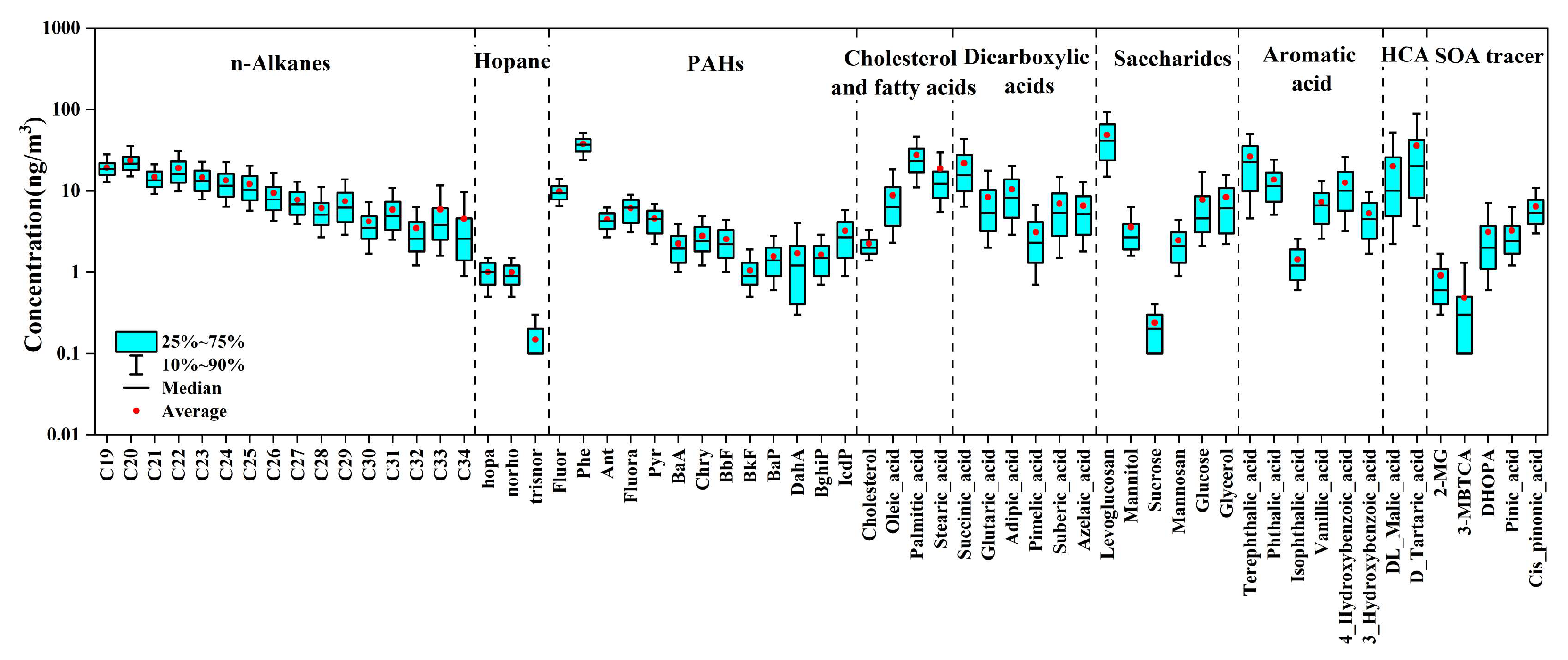

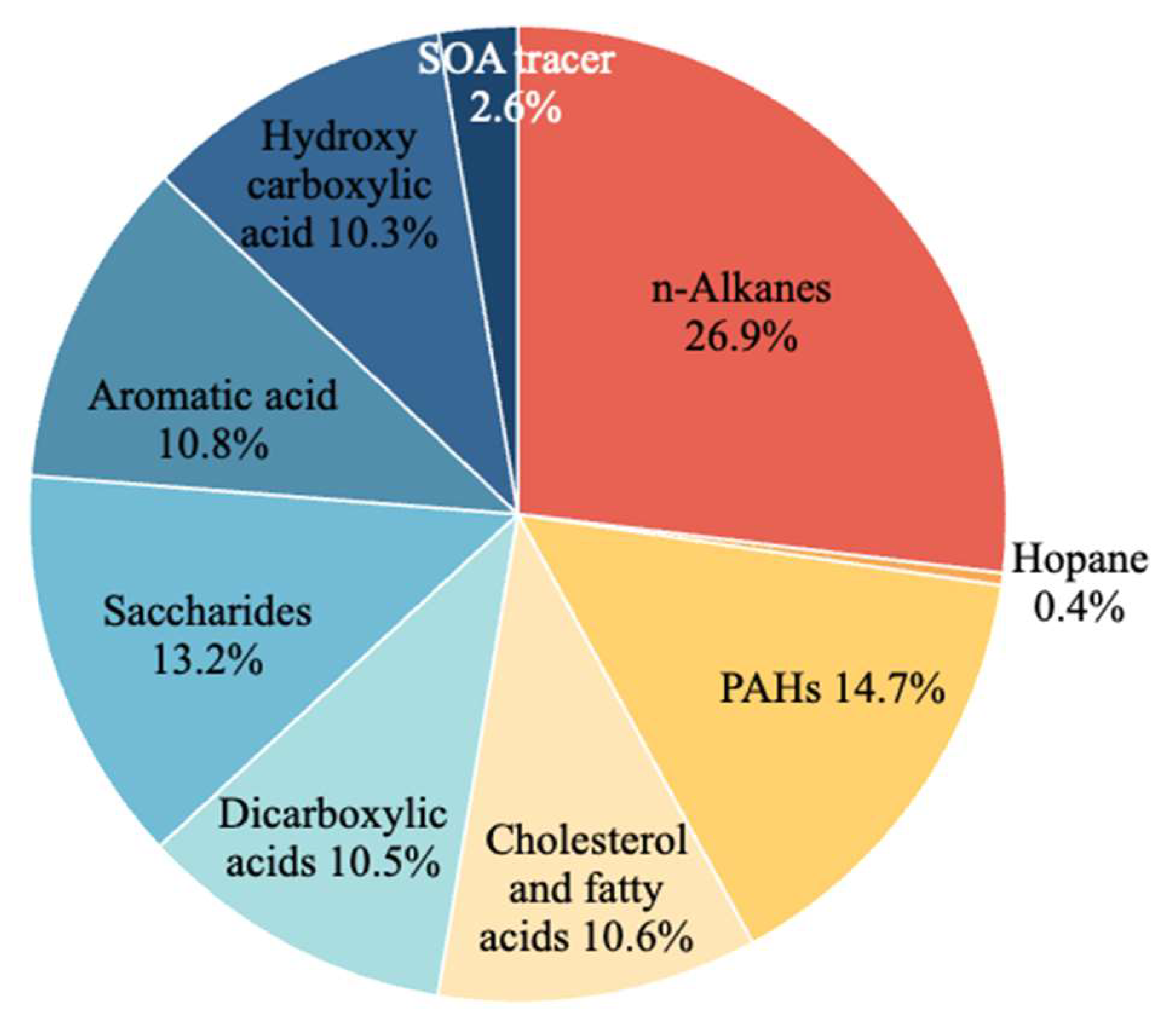
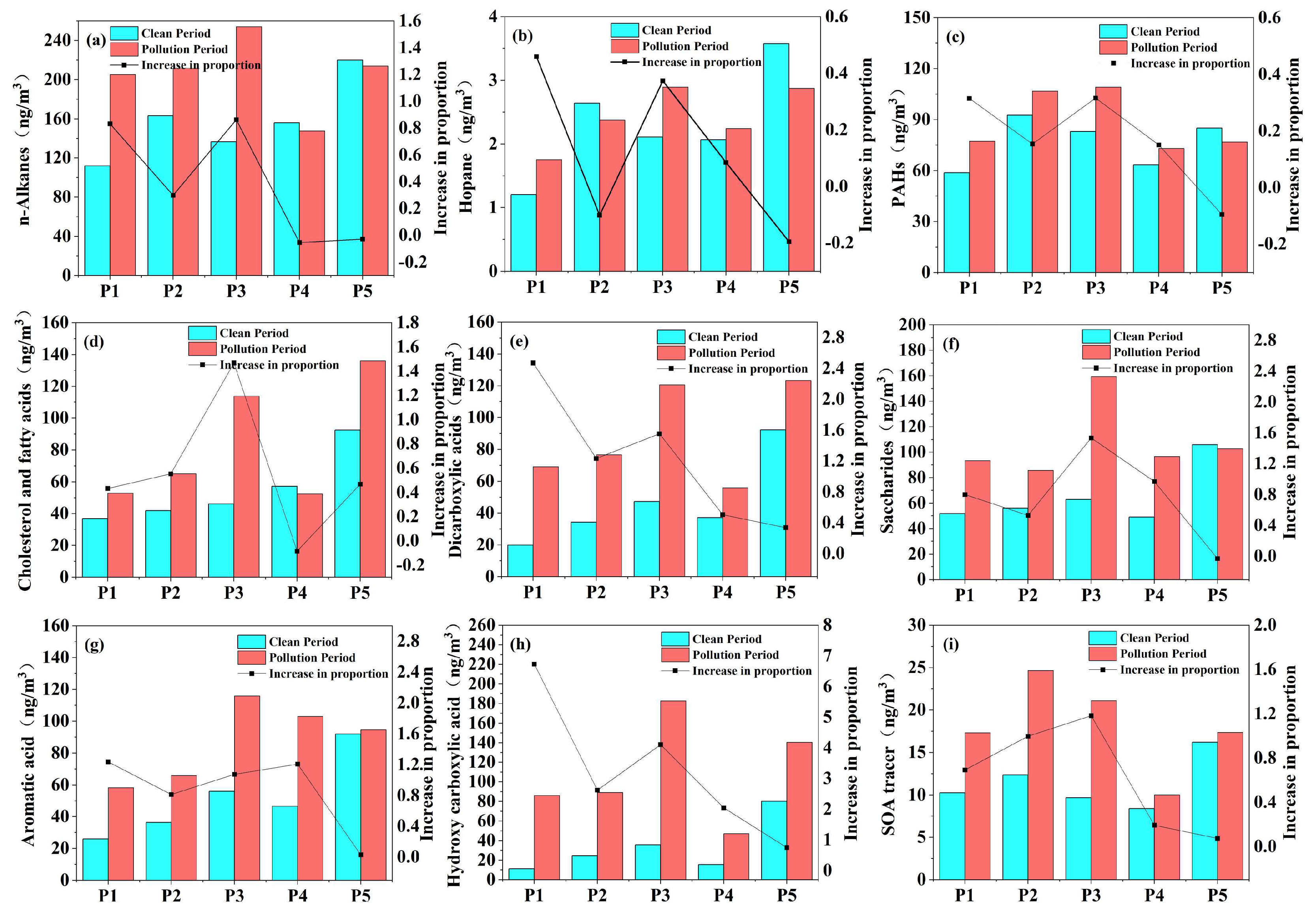
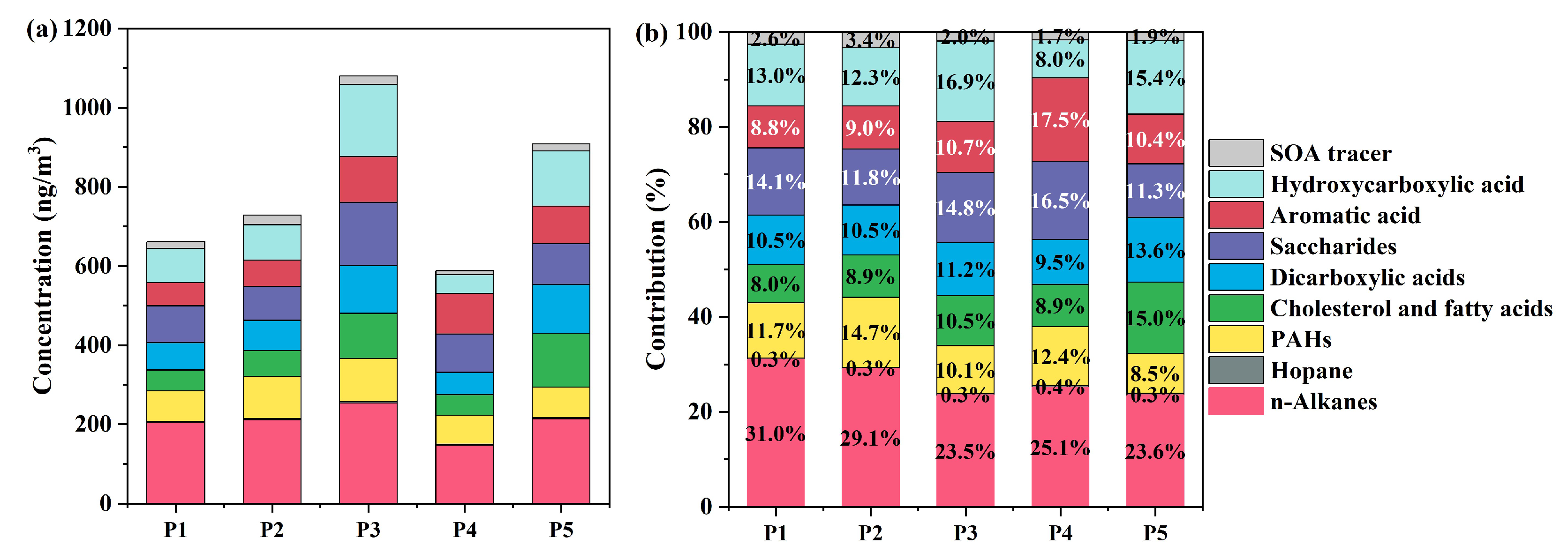
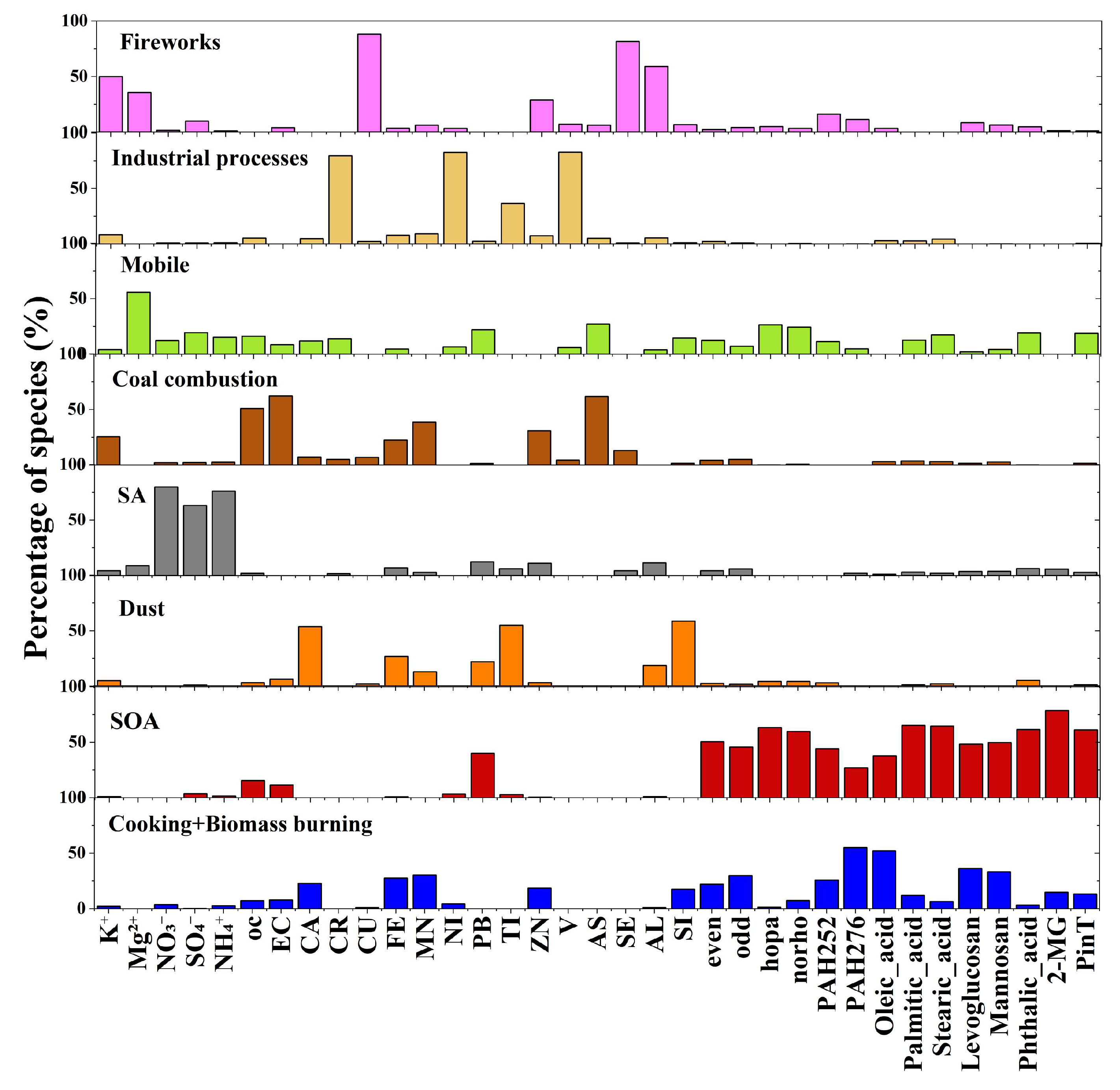

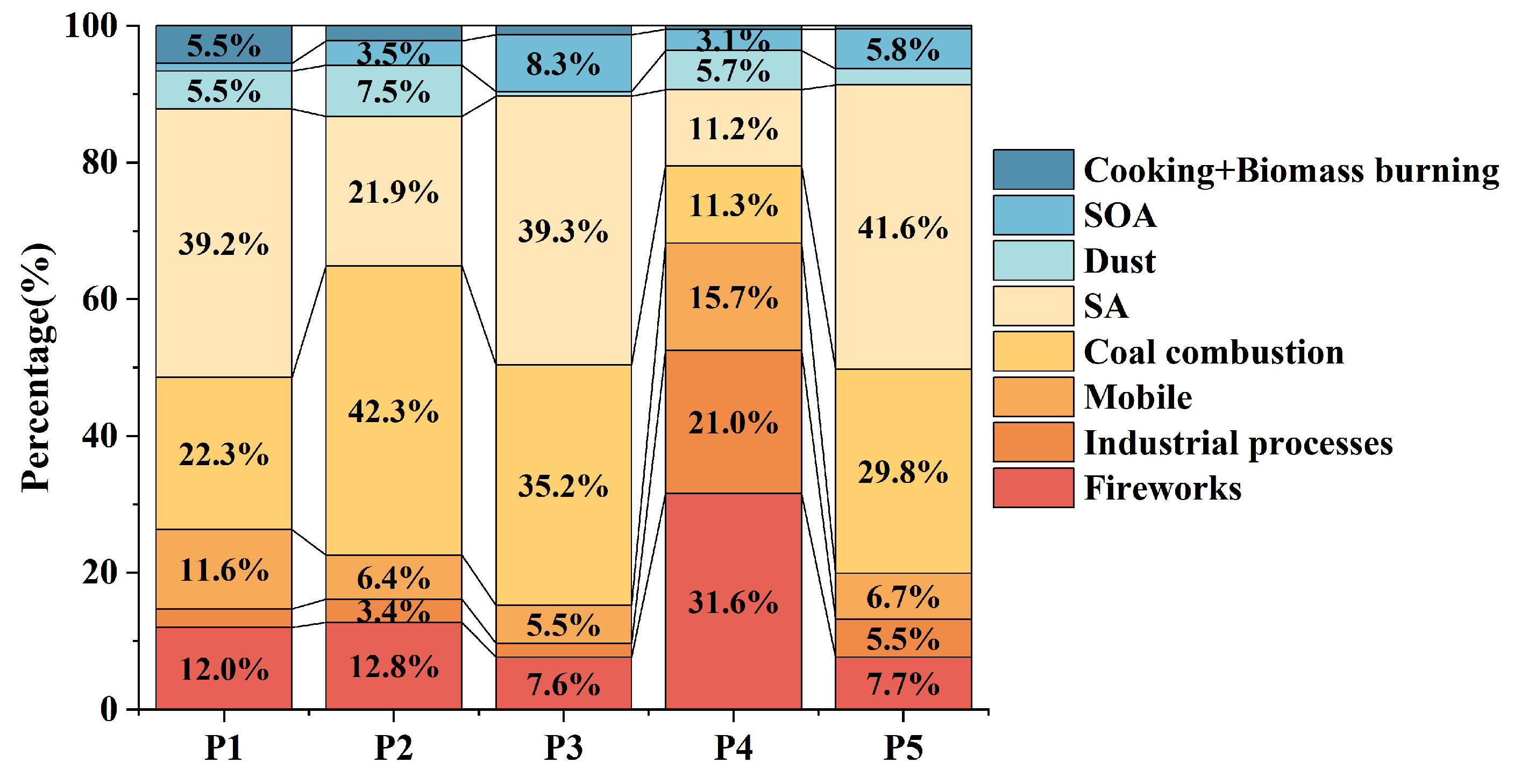

| No. | Type | Types of Organic Molecules | Concentration (ng/m3) | Main Sources |
|---|---|---|---|---|
| 1 | n-Alkanes | C19–C34 | 145.7 ± 77.2 | Fossil fuel combustion & terrestrial plant release et al. [30,31] |
| 2 | Hopanes | αβ-Hopane, αβ-Norhopane, 17α(H)-22,29,30-Trisnorhopane | 2.2 ± 0.8 | Fossil fuel combustion [14] |
| 3 | PAHs | Fluorene, Phenanthrene, Anthracene, Fluoranthene, Pyrene, Benzo_a_anthracene, Chrysene, Benzo_b_fluoranthene, Benzo_k_fluoranthene, Benzo_a_pyrene, Dibenz_a_h_anthracene, Benzo_ghi_perylene, Indeno_123_cd_pyrene | 79.5 ± 24.2 | Various combustion sources (mainly coal combustion sources) [32,33] |
| 4 | Cholesterol and fatty acids | Oleic acid, stearic acid, palmitic acid, and cholesterol | 57.4 ± 43.0 | Cooking [34] |
| 5 | Dicarboxylic acids | succinic acid, glutaric acid, adipic acid, pimelic acid, suberic acid, azelaic acid | 56.7 ± 40.7 | secondary formation [35] |
| 6 | Saccharides | Dextran, mannitol, sucrose, mannan, glucose, glycerol | 71.2 ± 41.7 | Industry sources, biomass burning & terrestrial plant release [36,37] |
| 7 | Aromatic acid | Terephthalic acid, phthalic acid, isophthalic acid, vanillic acid, 4-hydroxybenzoic acid, 3-hydroxybenzoic acid | 58.7 ± 38.8 | road mobile sources & secondary formation [38,39] |
| 8 | Hydroxycarboxylic acid | Malic acid, tartaric acid | 55.7 ± 68.5 | Secondary formation [35] |
| 9 | SOA tracer | 2-methylglyceric acid, 3-methyl-1,2,3-butanetricarboxylic acid, 2,3-dihydroxy-4-oxopentanoic acid, pinic acid, Cis-pinonic acid | 14.1 ± 9.6 | SOA [40,41] |
| 10 | Total amount of TAG substance | 541.3 ± 344.5 |
| No. | Species | Organic Molecules | Average Concentration (ng/m3) | Main Sources | LOD |
|---|---|---|---|---|---|
| 1 | Alk_odd | n-C25, n-C27, n-C29, n-C31 and n-C33 | 44.6 ± 26.8 | terrestrial plant release, Fossil fuel combustion [42] | / |
| 2 | Alk_even | n-C24, n-C26, n-C28, n-C30 and n-C32 | 41.1 ± 24.5 | Fossil fuel combustion [43] | / |
| 3 | Hopane | Hopane | 1.0 ± 0.5 | Fossil fuel combustion [44] | / |
| 4 | Norhopane | Norhopane | 1.0 ± 0.5 | Fossil fuel combustion [44] | / |
| 5 | PAHs_252 | Benzo[b+k]fluoranthene, Benzo[a]pyrene | 3.8 ± 2.4 | Combustion source [45] | / |
| 6 | PAHs_276 | Benzo[g,h,i]perylene, Indeno[1,2,3-cd]pyrene | 5.1 ± 4.2 | Combustion source [46] | / |
| 7 | Oleic_acid | Oleic acid | 8.5 ± 8.6 | Cooking [47] | / |
| 8 | Palmitic_acid | Palmitic acid | 30.1 ± 21.0 | Cooking [47] | / |
| 9 | Stearic_acid | Stearic acid | 21.5 ± 31.6 | Cooking [47] | / |
| 10 | Levoglucosan | Levoglucosan | 56.5 ± 39.5 | biomass burning [44] | / |
| 11 | Mannosan | Mannosan | 2.7 ± 2.1 | biomass burning [44] | / |
| 12 | Phthalic_acid | Phthalic acid | 11.8 ± 11.1 | Oxidation of naphthalene and its derivatives [48] | 0.009 |
| 13 | 2_MGA | 2-Methylglyceric acid | 0.7 ± 0.5 | Isoprene oxidation products [49] | 0.0717 |
| 14 | α-PinT | Pinic acid, Cis-pinonic acid | 10.3 ± 7.8 | α- Pinene Oxidation Products [49] | 0.0143 |
| Cluster | P1 | P2 | P3 | P4 | P5 |
|---|---|---|---|---|---|
| Cluster_1 | 98.2 | 180.1 | 76.7 | 35.5 | 87.8 |
| Cluster_2 | 41.8 | 88.8 | 56.9 | 34.2 | 206.2 |
| Cluster_3 | 204.8 | 98.9 | 172.5 | 157.2 | 89.8 |
| Cluster_4 | 119.7 | 139.5 | 60.3 | ||
| Cluster_5 | 43.1 | 145.8 |
Disclaimer/Publisher’s Note: The statements, opinions and data contained in all publications are solely those of the individual author(s) and contributor(s) and not of MDPI and/or the editor(s). MDPI and/or the editor(s) disclaim responsibility for any injury to people or property resulting from any ideas, methods, instructions or products referred to in the content. |
© 2025 by the authors. Licensee MDPI, Basel, Switzerland. This article is an open access article distributed under the terms and conditions of the Creative Commons Attribution (CC BY) license (https://creativecommons.org/licenses/by/4.0/).
Share and Cite
Chen, N.; Du, Y.; Wang, Y.; Yi, Y.; Wilasang, C.; Feng, J.; Zhang, K.; Manomaiphiboon, K.; Huang, L.; Yang, X.; et al. Source Identification of PM2.5 and Organic Carbon During Various Haze Episodes in a Typical Industrial City by Integrating with High-Temporal-Resolution Online Measurements of Organic Molecular Tracers. Sustainability 2025, 17, 10587. https://doi.org/10.3390/su172310587
Chen N, Du Y, Wang Y, Yi Y, Wilasang C, Feng J, Zhang K, Manomaiphiboon K, Huang L, Yang X, et al. Source Identification of PM2.5 and Organic Carbon During Various Haze Episodes in a Typical Industrial City by Integrating with High-Temporal-Resolution Online Measurements of Organic Molecular Tracers. Sustainability. 2025; 17(23):10587. https://doi.org/10.3390/su172310587
Chicago/Turabian StyleChen, Nan, Yufei Du, Yangjun Wang, Yanan Yi, Chaiwat Wilasang, Jialiang Feng, Kun Zhang, Kasemsan Manomaiphiboon, Ling Huang, Xudong Yang, and et al. 2025. "Source Identification of PM2.5 and Organic Carbon During Various Haze Episodes in a Typical Industrial City by Integrating with High-Temporal-Resolution Online Measurements of Organic Molecular Tracers" Sustainability 17, no. 23: 10587. https://doi.org/10.3390/su172310587
APA StyleChen, N., Du, Y., Wang, Y., Yi, Y., Wilasang, C., Feng, J., Zhang, K., Manomaiphiboon, K., Huang, L., Yang, X., & Li, L. (2025). Source Identification of PM2.5 and Organic Carbon During Various Haze Episodes in a Typical Industrial City by Integrating with High-Temporal-Resolution Online Measurements of Organic Molecular Tracers. Sustainability, 17(23), 10587. https://doi.org/10.3390/su172310587









